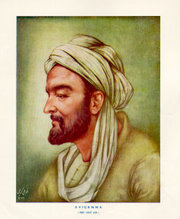Ibn Sina (Avicenna)
(980-1037 C.E.) - Doctor of Doctors

Ibn Sina was an Islamic philosopher and physician, of Persian origin, born near Bukhara which is Uzbekistan in the present time. He was the most renowned philosopher of medieval Islam and the most influential name in medicine from 1100 to 1500. He wrote almost 450 treatises on a wide range of subjects, of which around 240 have survived. In particular, 150 of his surviving treatises concentrate on philosophy and 40 of them concentrate on medicine. His medical masterpiece was the Qanun (Canon of Medicine) , which was a standard medical text at many medieval universities. The book is known for the discovery of contagious diseases, the introduction of quarantine to limit the spread of infectious diseases, the introduction of experimental medicine, clinical trials, neuropsychiatry, risk factor analysis and the idea of syndrome in the diagnosis of specific diseases, and hypothesized the existence of microrganisms.
His other masterpiece, Kitab al-Shifa (Book of Healing), is a vast philosophical and scientific encyclopaedia which deals with logic, natural sciences, mathematics and metaphysics. Due to his ideas and accomplishment he was known as Father of Modern Medicine. He was also noted for Avicennia Logic; concepts of inertia and momentum, forrunner of psychoanalysis; important contributor to geology; and pioneer of aromatherapy and neuropsychiatry.
Ibn Sina whose full name is Abu Ali Al-Husayn Ibn Abdullah Ibn Sina was a foremost physician and philosopher of his time. He was also an astronomer, chemist, geologist, Hafiz, Islamic psychologist, Islamic scholar, Islamic theologian, logician, paleontologist, mathematician, Maktab teacher, physicist, poet, and scientist.
In any age Ibn Sina, would have been a giant among giants. He displayed exceptional intellectual prowess as a child and at the age of ten was already proficient in the Qur'an and the Arabic classics. He turned his attention to Medicine at the age of 17 years. By the age of 18 he had built up a reputation as a physician and was summoned to attend the Samani ruler Nuh ibn Mansur (reigned 976-997 C.E.), who, in gratitude for Ibn Sina's services, allowed him to make free use of the royal library, which contained many rare and even unique books. Endowed with great powers of absorbing and retaining knowledge, this Muslim scholar devoured the contents of the library and at the age of 21 was in a position to compose his first book.
Many of his works can be seen in the museum at Bukhara, where there are displays showing many of his writings, surgical instruments from the period and paintings of patients undergoing treatment. An impressive monument to the life and works of the man who became known as the 'Doctor of Doctors' still stands outside Bukhara museum and his portrait hangs in the Hall of the Faculty of Medicine in the University of Paris.